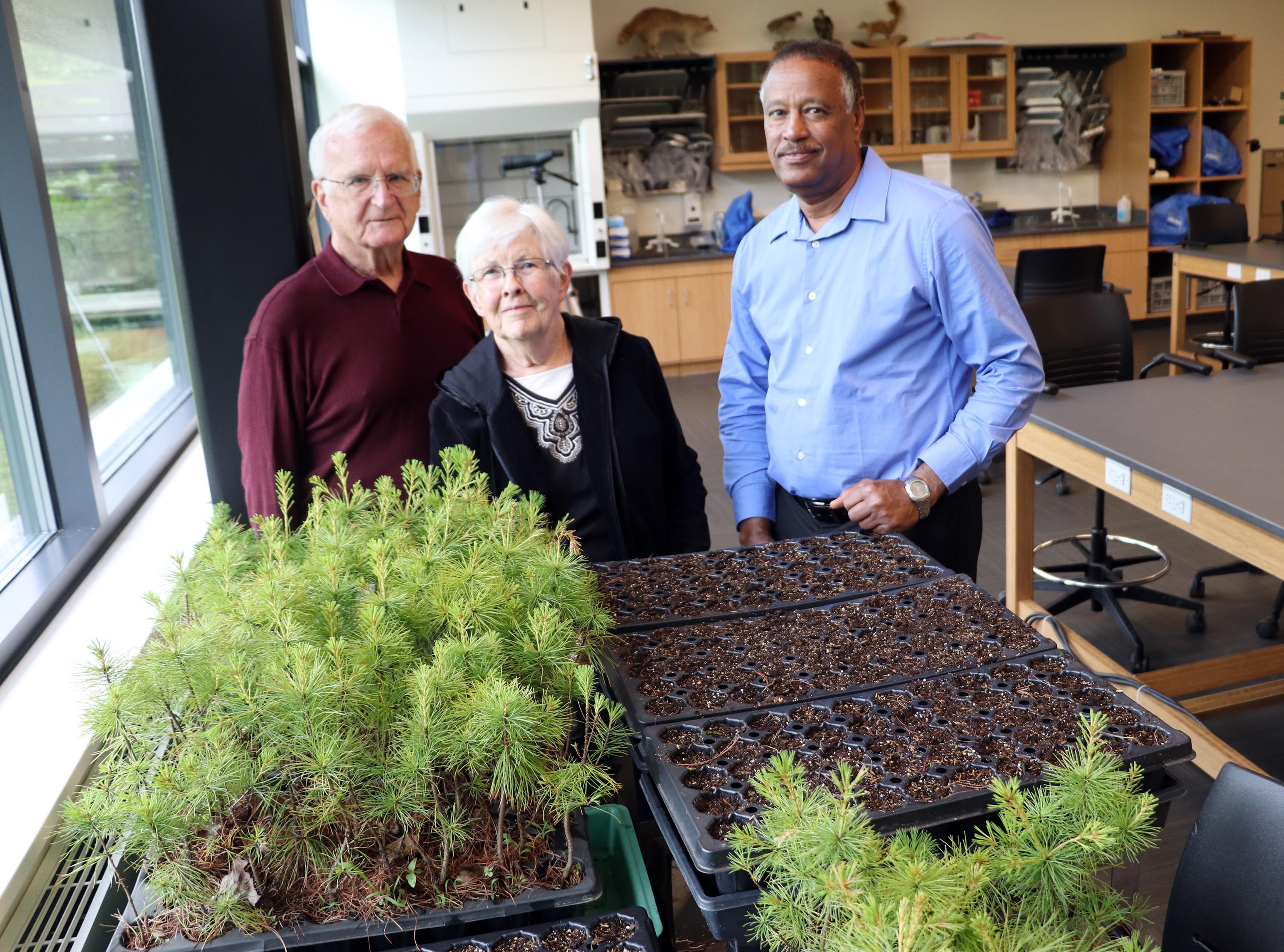Rooting for trees -- From left, Arizona residents and New York state canal system boaters George and Jane Pauk join SUNY Oswego's Kamal Mohamed in a lab at Rice Creek Field Station, where white oak seeds are germinating and white pine seedlings are growing for the Pauks' Canal Forest Restoration Project.
Dr. Kamal Mohamed, director of SUNY Oswego's Rice Creek Biological Field Station, has signed on to assist -- and expand -- a citizen-science project to repopulate white oak and white pine trees along the New York state canal system and surrounding areas.
Undertaken by retired physician George Pauk and his wife Jane, the Canal Forest Restoration Project has recruited volunteers and obtained seeds and seedlings from the state Department of Environmental Conservation and elsewhere. The project now has access to a new 2,500-square-foot enclosure at Rice Creek for protecting potted trees until ready for transplant, as well as space in the field station itself for germinating seeds.
"They (the Pauks) are interested in repopulating white oaks and white pines, which for many generations were over-exploited for building ships, barrels and structures," said Mohamed, a professor of biological sciences at Oswego. "There are very few places left in the area with these trees."
The Pauks, boaters for all 59 years of their marriage, said they have spent thousands of dollars of their own to support the effort, including such supplies as soil and pots.
"We've boated all over the world," said Pauk, a former physician with the Indian Health Service who spends winters in Arizona and uses a Brewerton marina as a base in good weather. "We became aware that boaters had a debt to pay to the white oak and white pine."
White oak once grew in forests throughout the Northeast, including Upstate New York. "They were sought out and wiped out," Pauk said. Similarly, white pine grew straight and tall -- often over 100 feet -- along rivers and canal routes.
In the days of wooden ships, white oak was prized for its resistance to water and rot; the hull of the USS Constitution -- "Old Ironsides" -- was made of white oak and live oak. The white oak's acorns were feed for farm animals, Pauk said. The tree remains the preferred wood for barrels in wineries and whiskey distilleries, and continues to be used to craft outdoor and other furniture.
White pine historically was used for ships' masts and yardarms and still is used for decking. Builders of the Erie Canal, and the canals that sprang from it, used white oak for lock doors and other construction needs, he said.
Collegiate partner
Until last summer when it closed, a nursery in Newark was home base for the Canal Forest Restoration Project, Pauk said. Last winter, he began looking for potential partners among colleges and universities near major canals. He called Mohamed.
"Kamal immediately recognized this as a good project," Pauk said.
A botanist by training, Mohamed recognizes the threat to trees such as the ash, whose very existence in forests is threatened by the invasive emerald ash borer. He has summer interns working on invasive-species projects and poised to help with the Canal Forest Restoration Project.
"It is getting very serious," he said. "If those ashes are gone, we have to have a plan for replacing them. George enlightened me about the white oak, and I was amazed by his knowledge."
In turn, Mohamed has been able to bring his knowledge of plants and genetics to the project. For example, he knew that while the wood of the white oak and the swamp white oak (which grows in wet woods, swamps and bottomlands) can be indistinguishable, the undersides of the swamp oak's leaves are silvery white with star-shaped hairs and have shallower lobes.
Primarily, the Pauks and Mohamed see the project's educational benefits as an opportunity to make students and other area residents aware of the region's rich arboreal heritage and the potential for regaining some of what was lost, albeit over a relatively long span of time. The New York State Nursery in Saratoga gives the project young trees, and the project distributes them for free, along with instructions on caring for and protecting them from deer, rabbits and mice.
"White oaks that still exist are those protected by people," Pauk said. "You see them in yards and in towns and cities."
The Pauks plan to appear at summer gathering places such as the Oswego-Fulton Farmers Market, where they will talk about the Canal Forest Restoration Project and hand out literature, seeds and seedlings.
Mohamed plans to expand the project. "With the help of the Pauk family, Rice Creek's goal is to grow its own trees -- white pine and white and swamp white oaks -- from seeds starting next year," he said. "We still welcome the help from the DEC; our objective is distribute up to 2,000 trees annually."
With the help of SUNY Oswego interns, Mohamed would like to transplant up to 1,000 this year on Rice Creek's mixed terrain and perhaps some on the main campus. The field station's 400 acres and trail system welcome residents to hike and take part in nature programming.
"It's wonderful to have an educational institution -- a public educational institution -- involved now," said Pauk. "It's terrific. A biology department -- it's amazing!"
Find more information on:




